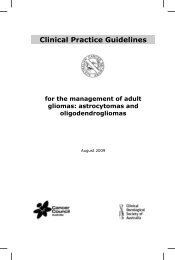Clinical Practice Guidelines for the management of locally advanced ...
Clinical Practice Guidelines for the management of locally advanced ...
Clinical Practice Guidelines for the management of locally advanced ...
You also want an ePaper? Increase the reach of your titles
YUMPU automatically turns print PDFs into web optimized ePapers that Google loves.
Recommendation<br />
There is insufficient evidence to support <strong>the</strong> use <strong>of</strong> surgery in <strong>the</strong> <strong>management</strong> <strong>of</strong> <strong>advanced</strong><br />
prostate cancer, with <strong>the</strong> possible exception <strong>of</strong> a transurethral resection <strong>of</strong> <strong>the</strong> prostate in<br />
men who are unable to void after androgen deprivation <strong>the</strong>rapy.<br />
Grade C<br />
Fur<strong>the</strong>r appropriately designed randomised trials should be undertaken to determine whe<strong>the</strong>r surgery<br />
has a significant role in <strong>the</strong> <strong>management</strong> <strong>of</strong> men with <strong>locally</strong> <strong>advanced</strong> prostate cancer, o<strong>the</strong>r than to<br />
relieve urinary outlet obstruction in conjunction with androgen deprivation <strong>the</strong>rapy.<br />
3.1.5 Surgery plus androgen deprivation <strong>the</strong>rapy<br />
The <strong>management</strong> <strong>of</strong> patients with <strong>locally</strong> <strong>advanced</strong> prostate cancer has been influenced by <strong>the</strong><br />
introduction <strong>of</strong> androgen deprivation <strong>the</strong>rapy (ADT). This review focuses on patients with <strong>locally</strong><br />
<strong>advanced</strong> disease (ie pT3 or higher). Patients with T1 or T2 disease are dealt with in o<strong>the</strong>r guidelines.<br />
The inclusion <strong>of</strong> patients with pT3 or higher was due to <strong>the</strong> older literature studying patients based on<br />
volume <strong>of</strong> disease ra<strong>the</strong>r than histological grade. Moreover, patients with bulky (palpable disease)<br />
represent a different clinical paradigm. The role <strong>of</strong> adjuvant ADT with radiation <strong>the</strong>rapy is discussed<br />
in section 3.1.3. The use <strong>of</strong> perioperative ADT in patients with <strong>locally</strong> <strong>advanced</strong> disease is discussed<br />
in <strong>the</strong> following clinical contexts:<br />
neoadjuvant setting<br />
post-radical prostatectomy short duration (two years)<br />
Fully resected pT3, T4, No/Nx disease<br />
Most <strong>of</strong> <strong>the</strong> studies assessing <strong>the</strong> effects <strong>of</strong> neoadjuvant ADT focussed on patients with lower-stage<br />
disease and thus were excluded from this analysis. Those studies evaluating neoadjuvant ADT <strong>for</strong><br />
prostatectomy patients with <strong>locally</strong> <strong>advanced</strong> disease predominantly reported changes in pathological<br />
stage. None was found that assessed survival. As a result, <strong>the</strong>re are no available data on which to base<br />
a recommendation on neoadjuvant <strong>the</strong>rapy <strong>for</strong> <strong>locally</strong> <strong>advanced</strong> disease. There is one continuing<br />
phase III trial <strong>of</strong> hormonal <strong>the</strong>rapy plus docetaxel followed by surgery, versus surgery alone, <strong>for</strong><br />
patients with high-risk disease (including patients with <strong>locally</strong> <strong>advanced</strong> disease (CALGB 90203<br />
study).<br />
There were no studies <strong>of</strong> short duration (six months or less) ADT as an adjuvant to prostatectomy <strong>for</strong><br />
<strong>locally</strong> <strong>advanced</strong> disease. Two low-quality RCTs have examined <strong>the</strong> effects on survival <strong>of</strong> prolonged<br />
hormonal <strong>the</strong>rapy as an adjuvant to prostatectomy or prostatectomy plus pelvic lymphadenectomy.<br />
One was a subgroup analysis and included some patients (4.3%) with radiologically- or biopsy-proven<br />
positive nodes. 6 In <strong>the</strong> o<strong>the</strong>r study, patients also underwent a pelvic lymphadenectomy and only those<br />
who were pT3–4N0 were included in <strong>the</strong> study. 23 In both studies <strong>the</strong> ADT was limited to antiandrogen<br />
alone. Nei<strong>the</strong>r study showed a survival advantage <strong>for</strong> anti-androgens alone as post-operative<br />
adjuvant <strong>the</strong>rapy <strong>for</strong> patients with <strong>locally</strong> <strong>advanced</strong> disease. 6, 23 There were no data <strong>for</strong> medical or<br />
surgical castration as an adjuvant to surgery <strong>for</strong> fully resected primarily node-negative disease. As a<br />
result it is unknown whe<strong>the</strong>r <strong>the</strong> use <strong>of</strong> castration as adjuvant <strong>the</strong>rapy <strong>for</strong> patients with marginpositive<br />
disease or similar high-risk features will confer a survival advantage. This is <strong>the</strong> subject <strong>of</strong><br />
continuing clinical trials.<br />
<strong>Clinical</strong> practice guidelines <strong>for</strong> <strong>the</strong> <strong>management</strong> <strong>of</strong> <strong>locally</strong> <strong>advanced</strong> and metastatic prostate cancer<br />
34



